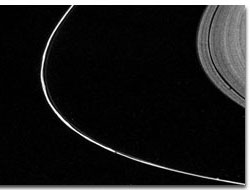|
CASSINI AT SATURN - Introduction

|
|
Saturn's F Ring taken from Voyager
|
On July 1, 2004 the Cassini-Huygens spacecraft will fire its main engine to reduce its speed, allowing the spacecraft to be captured by Saturn's gravity and enter orbit. The spacecraft will then begin a four-year tour of the ringed planet, its mysterious moons, the stunning rings, and its complex magnetic environment.
During the Saturn Tour, Cassini will complete 74 orbits of the ringed planet, 44 close flybys of the mysterious moon Titan, and numerous flybys of Saturn's other icy moons.

|
|
Artists' rendition of the Cassini spacecraft approaching Saturn
|
Key dates of the Saturn Tour are:
June 11, 2004 (19:32 UTC): Flyby of the furthest moon orbiting Saturn, Phoebe, at an altitude of 2,000 km (1,243 miles).
July 1, 2004: Crossing of Saturn's Ring Plane during the spacecraft's critical Saturn Orbit Insertion sequence.
Dec. 25, 2004: 02:00 UTC Huygens probe separates from the Cassini orbiter and begins its 21 day journey to Titan. Dec. 25 counts as day one and Jan. 14 is day 21.
Jan. 14, 2005: Huygens begins its descent through Titan's cloudy atmosphere, where it lands on the surface about two and half hours later. The probe is scheduled to encounter the upper fringes of Titan's atmosphere at 09:00 UTC.
Other highlights of the Saturn Tour include close encounters with Saturn's moons Enceladus, Titan, Hyperion, Dione, Rhea and Iapetus. For detailed list of events, see the Arrival Timeline
What's UTC? Check out "Living on Saturn Time."
|